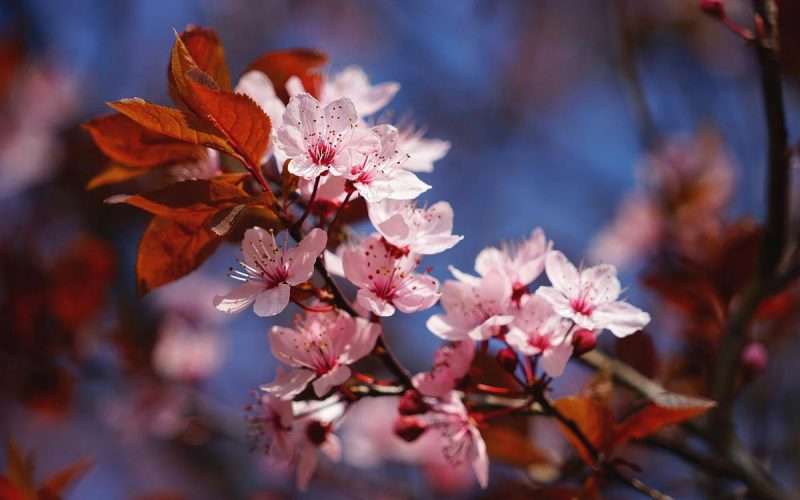Table of Contents Show
The cherry, literally, on top here is the idea that not all cherries are edible. Believe it or not, only a few cherry trees are not ornamental cherry trees.
And this is in spite of the fact that the cherry is one of the ‘pit’ fruits. Other trees producing fruits with pits include the Plum tree, Apple tree and Peach tree.
Cherry trees, though, are used more for flower production than anything else. Most in fact, are a species of mock cherry trees also known individually as an ornamental tree.
The mock cherry tree, or artificial tree, as it’s also referred to adds beauty to the landscape. Moreover, these trees are also an inherent part of Japanese culture.
Find that hard to believe? Maybe you’ve never seen a cherry tree in full bloom, outlined against the sky in all its delicate, majestic beauty.
If you’re planning on utilizing your garden soil to grow cherry trees, you should certainly read on further. This article is about beautifying your garden area, and will list a number of trees from the cherry family.
These subspecies of the cherry family are grown more for their looks and their role in beautifying your garden. They are, predictably, known as ornamental cherry trees.
The uses of your ornamental cherry tree
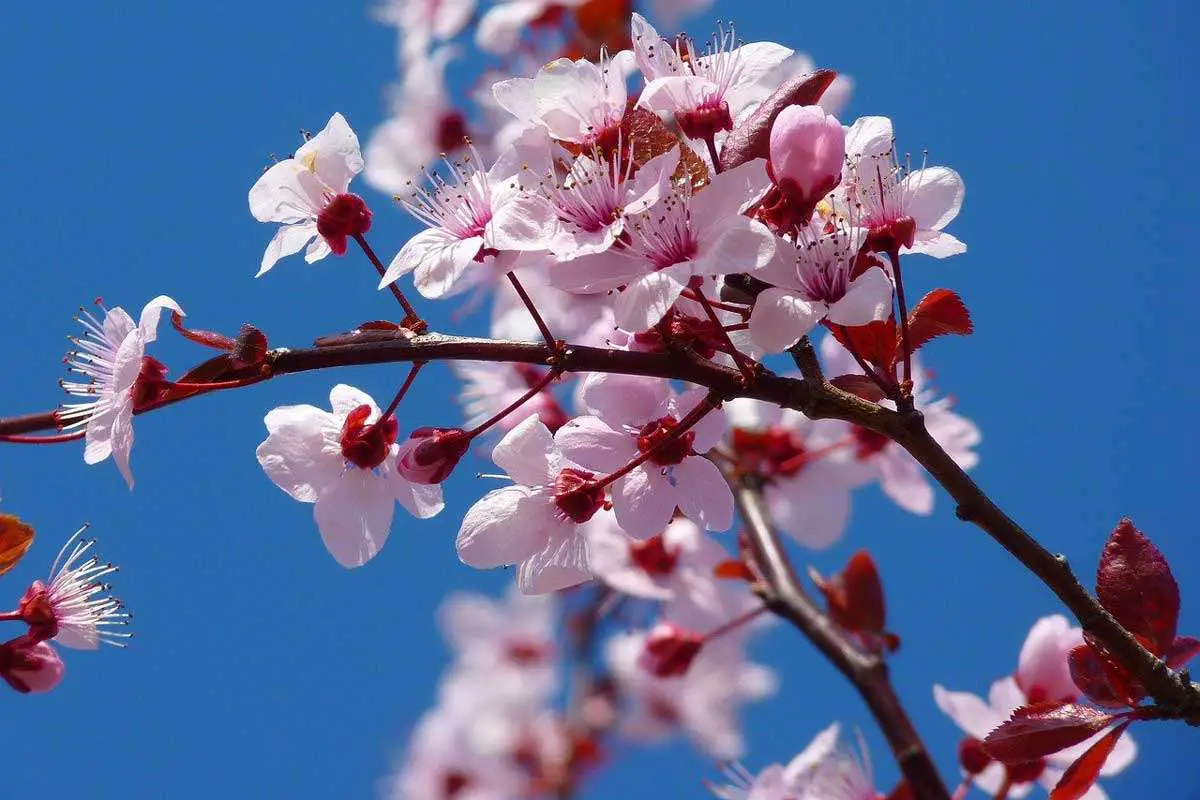
Ornaments are used to make the house, and the place it is being used in, look pretty. And that is exactly the case with ornamental cherry trees.
It’s only the aesthetics and the visual appeal it provides to an area that matter here. Many of the ornamental cherry trees bear fruits as well, but they are not edible.
These are mostly bitter in taste, although birds still love them. So not only is the tree itself an aesthetic treat, but the pretty birds it attracts are a bonus!
Types of Ornamental Cherry Tree
Planning on planting an ornamental cherry tree in your backyard or your front lawn? We have just the list to give you heads up on some of the prettiest ornamental cherry trees you can find!
Of course, the list could include more varieties but this’ll give you a good idea to go on.
1. Kwanzan: an ornamental cherry tree
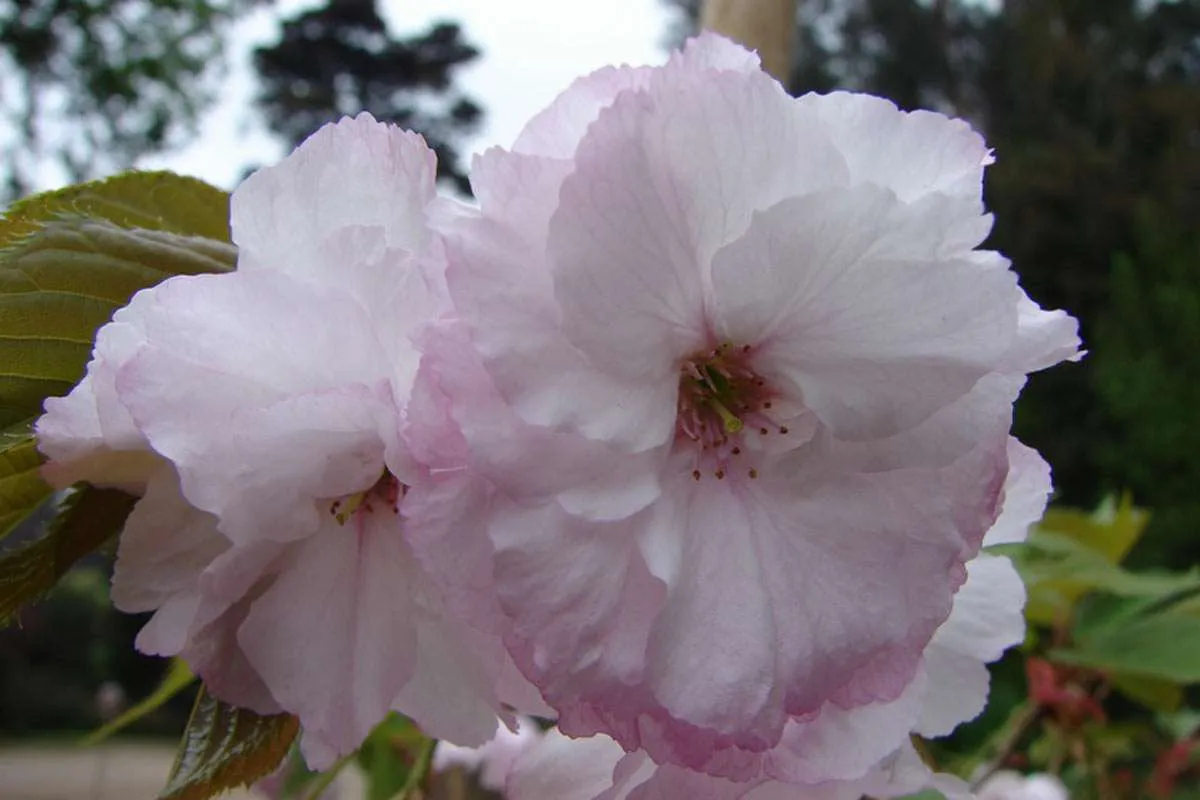
This ornamental cherry tree doesn’t bear any fruit and does not count as a fruit tree. That being the case, there’s no confusion whether or not it is edible.
The Kwanzan Cherry Tree can be considered as one of the most perfect ornamental cherry trees around. SInce it doesn’t bear any fruit, you don’t have to worry about its consumption either.
The cherry tree itself is a very low maintenance one. The flowers are beautiful to say the least. Very delicate, the pink double flowers of these blossom trees grow together in groups of three to five flowers.
The clusters of pink, but beautiful large and bright flowers of the ornamental cherry tree are stunning to look at. They also attract spectators and critics wherever they grow.
That is one fact backed by truth. The Kwanzan cherry tree has always been a fan favorite in every cherry blossom festival around the world. You can only imagine the stunning beauty of this ornamental cherry tree in spring.
2. Yoshino cherry tree
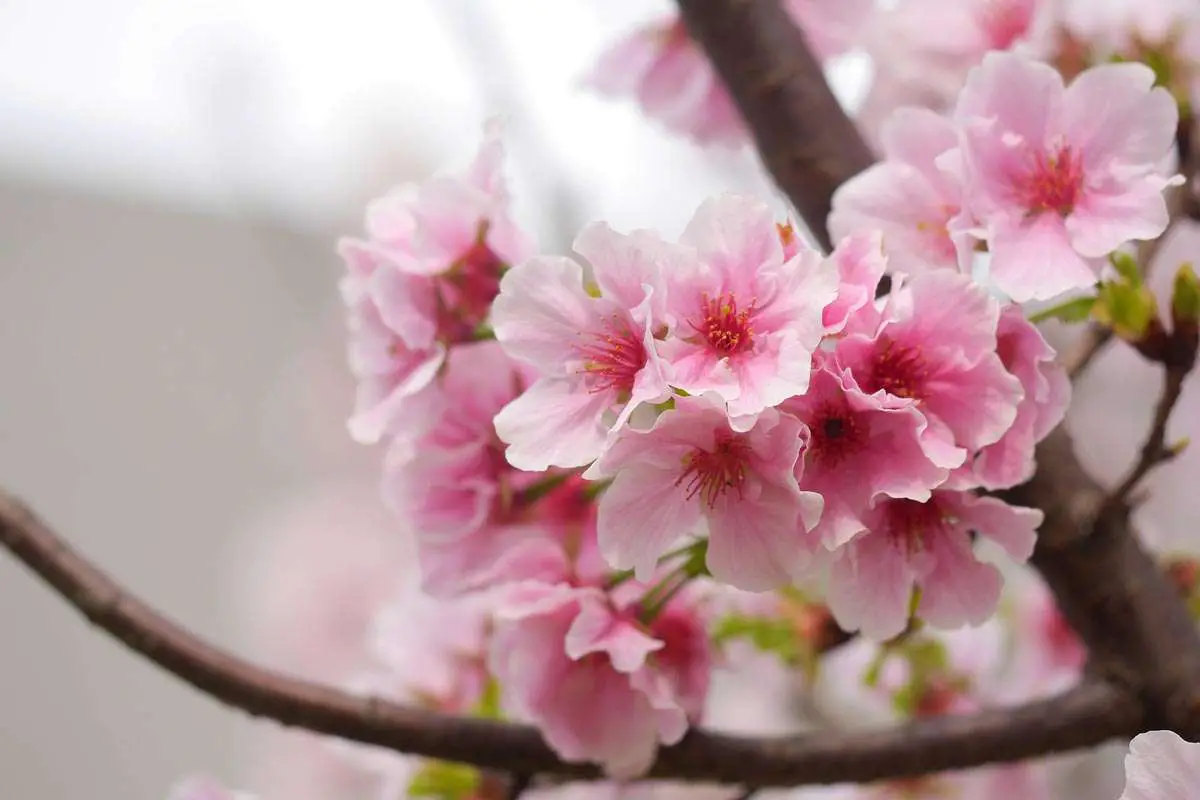
The second ornamental cherry tree in this comprehensive list has beautiful white flowers that grow in groups of two to five. Given its full and rich looking appearance, the Yoshino Cherry Tree in bloom is a beautiful sight indeed!
The flowers of the Yoshino Tree are delicate and white. Enough, as most viewers feel, to calm and soothe ruffled nerves and win admirers.
Adding a Yoshino cherry tree to your garden soil will definitely help give that beautiful, bridal touch to your garden. Best part of all, the Yoshino cherry, like any other cherry tree, blossoms early.
Within a year to three of being planted in the soil, you should expect your cherry blossoms! The flowers of the cherry blossom tree are beautiful. WIth petals that are white or pink in color, they add a dash of color to any landscape.
The fresh leaf cover will emerge after the peak flowering season is past. This means the flowers get to display themselves in all their beauty during the peak season.
3. Akebono cherry tree
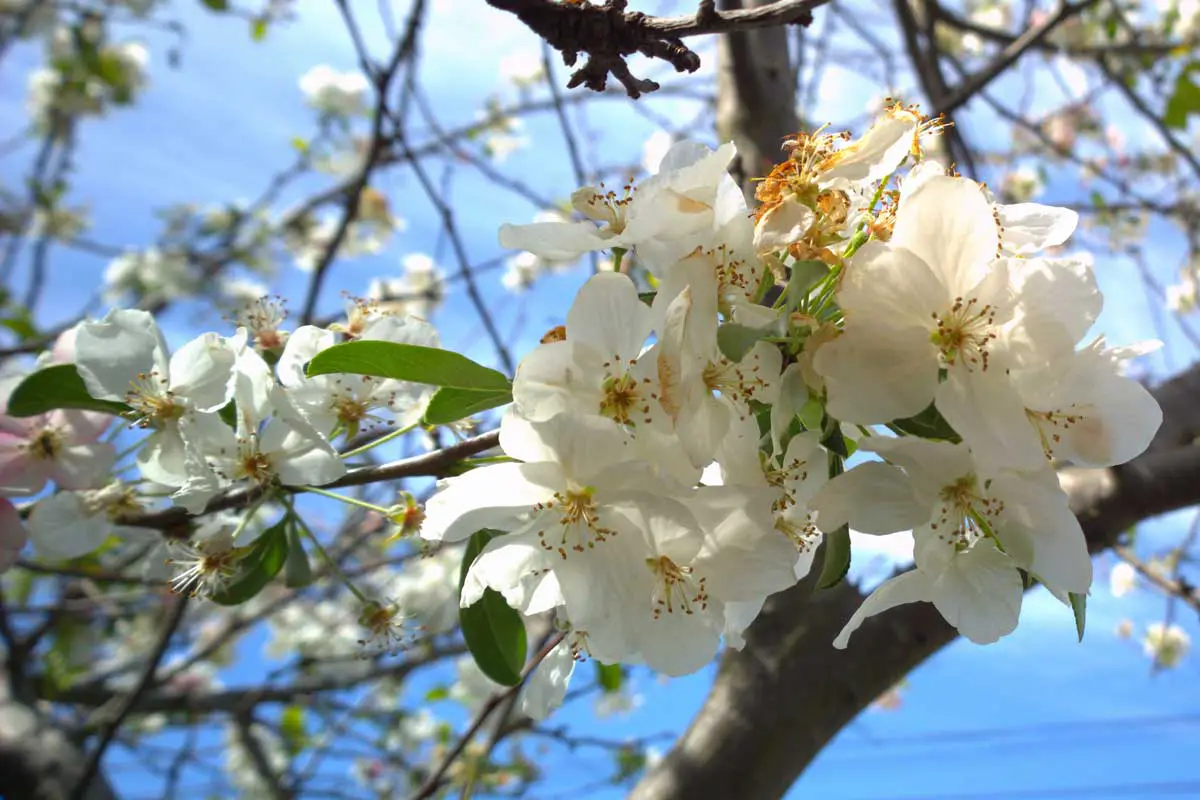
The special thing about this Ornamental Cherry Tree is that its flowers change colors. The flowers of Akebono Cherry Tree have a pale pink color that transitions to bright white during spring.
The aesthetics it brings with the changing color of its flowers is what makes this tree among the most beautiful ones. The awe-inspiring flowers of the Akebono Cherry Tree are single blossoms that grow in the groups of two to five.
Unfortunately, the Akebono Cherry Tree is losing popularity to newly evolved cherry blossoms, despite having so much beauty to offer.
4. Autumn Flowering Cherry Tree
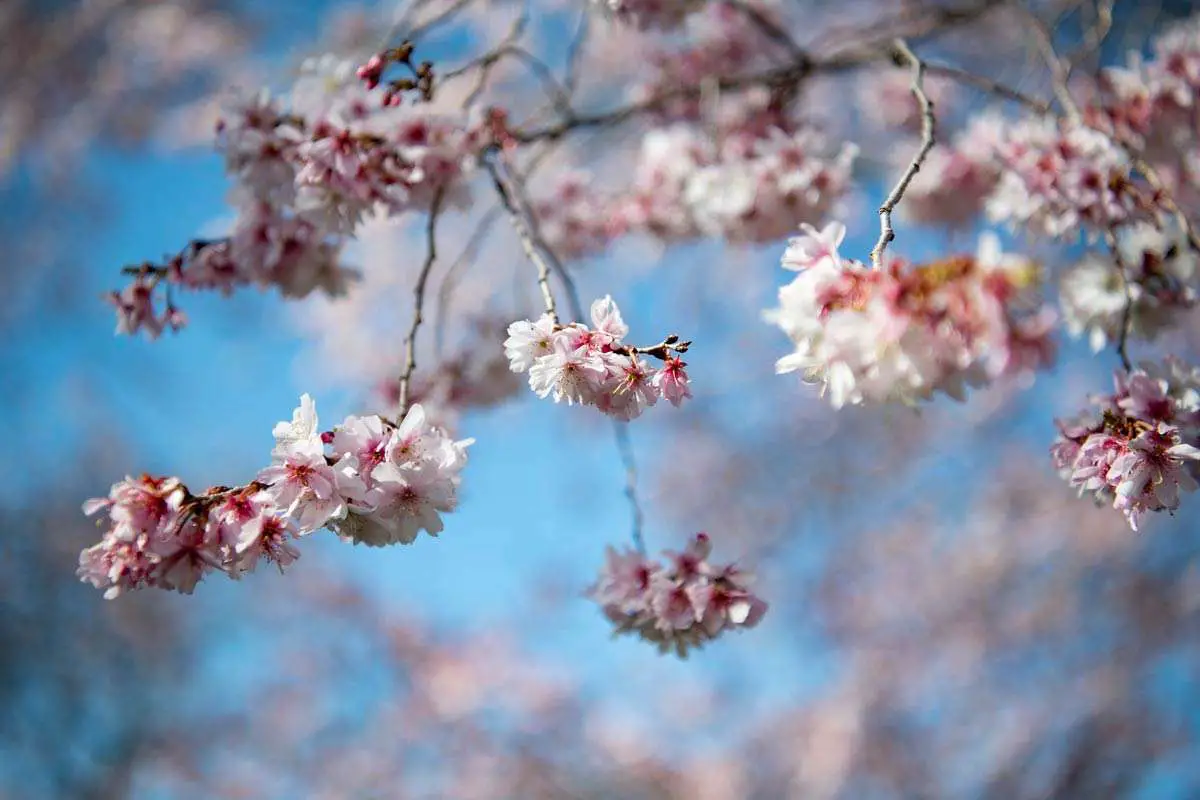
Its name is based on a special trait of this tree. The Autumn Flowering Cherry Tree is famous for its off season blooming.
During the part of the year in which every other tree is losing every single leaf, this ornamental cherry tree is in full bloom. The tree blooms twice every year, once in fall and then again in early spring.
5. North Japanese Hill Cherry Tree or Sargent Cherry
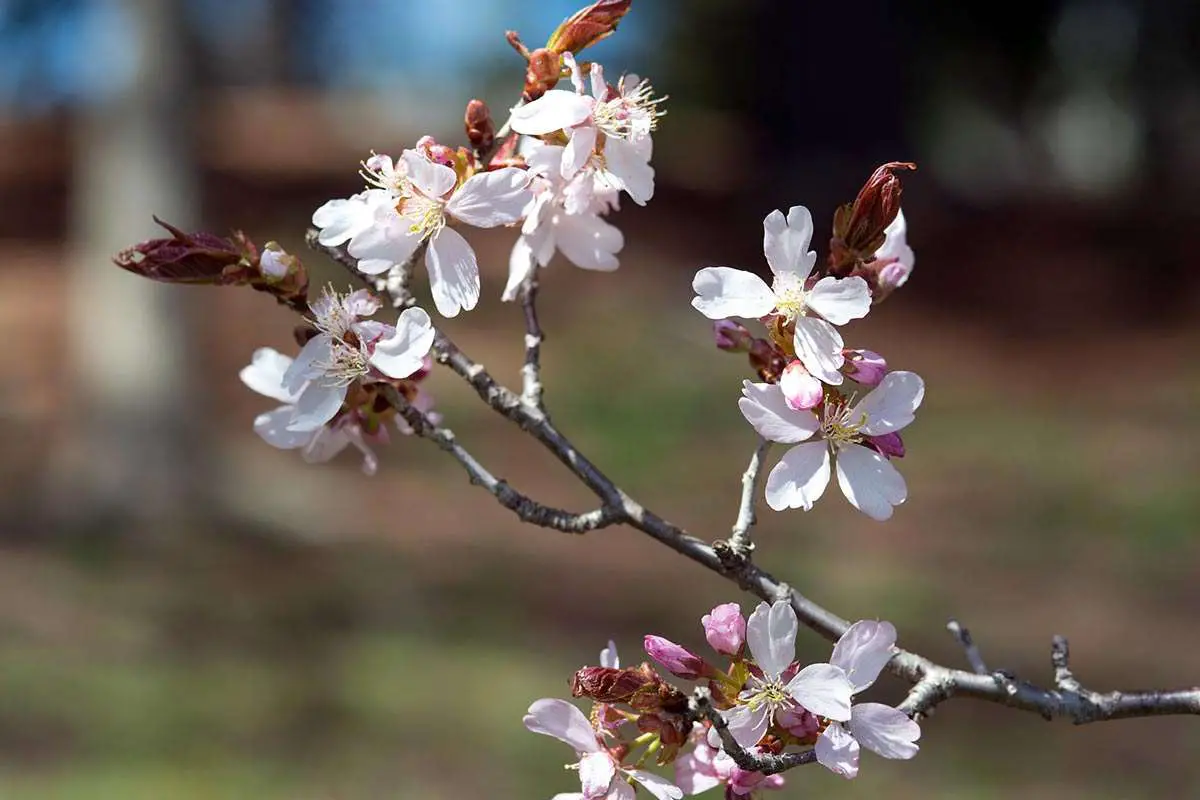
A single blossom, deep pink colored, clustered flower cherry tree, popularly associated with the Japanese Cherry Blossom. This Ornamental Cherry tree is native to both Japan and Korea.
People may associate this type of cherry tree to a single variety although that is not the case. There are a number of cherry trees that share the same aspect.
Its height gives the North Japanese Hill Cherry tree or Sargent Cherry tree an edge over other cherry blossom trees. Most other flowering cherry trees grow up to maximum heights of 40 feet. This ornamental cherry tree however, can easily grow up to a height of 60 feet in the wild.
6. Fugenzo or Shirofugen Cherry Tree
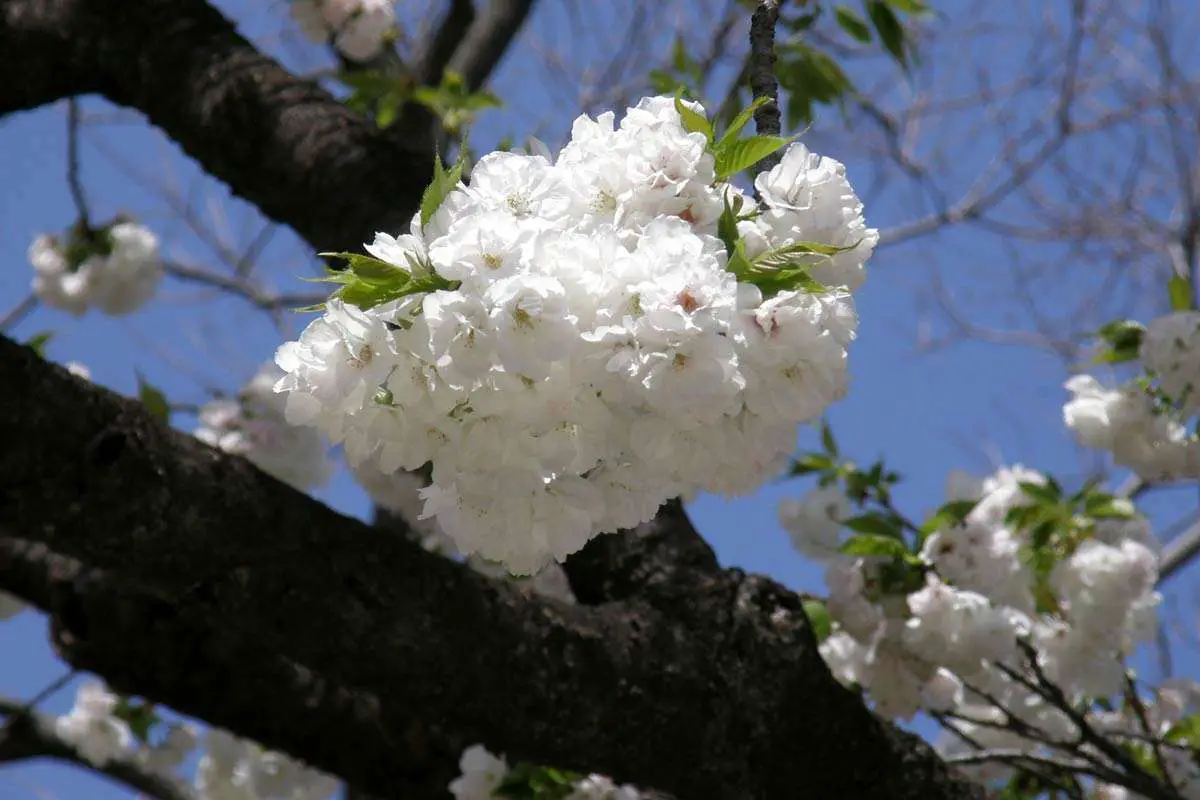
There is a huge, running debate on which is the exact country where cherry blossoms originated from. South Korea, Japan or China, this debate seems to have no end in sight.
However, one thing may not be denied… The cherry blossom trees have certainly originated from Far East Asia.
The Fugenzo or Shirofugen cherry tree originated in Japan. It is one of the oldest cherry trees that were cultivated in Japan. The flowers are double blossoms with 30-40 petals each.
These flowers have a wide range of color in their petals; from rose pink to light or nearly white color. Interestingly, these colors portray the age of the flower. The beautiful flower blooming on the Fugenzo Cherry Tree honors hundreds of years of Japanese tradition.
7. Okame Cherry Tree
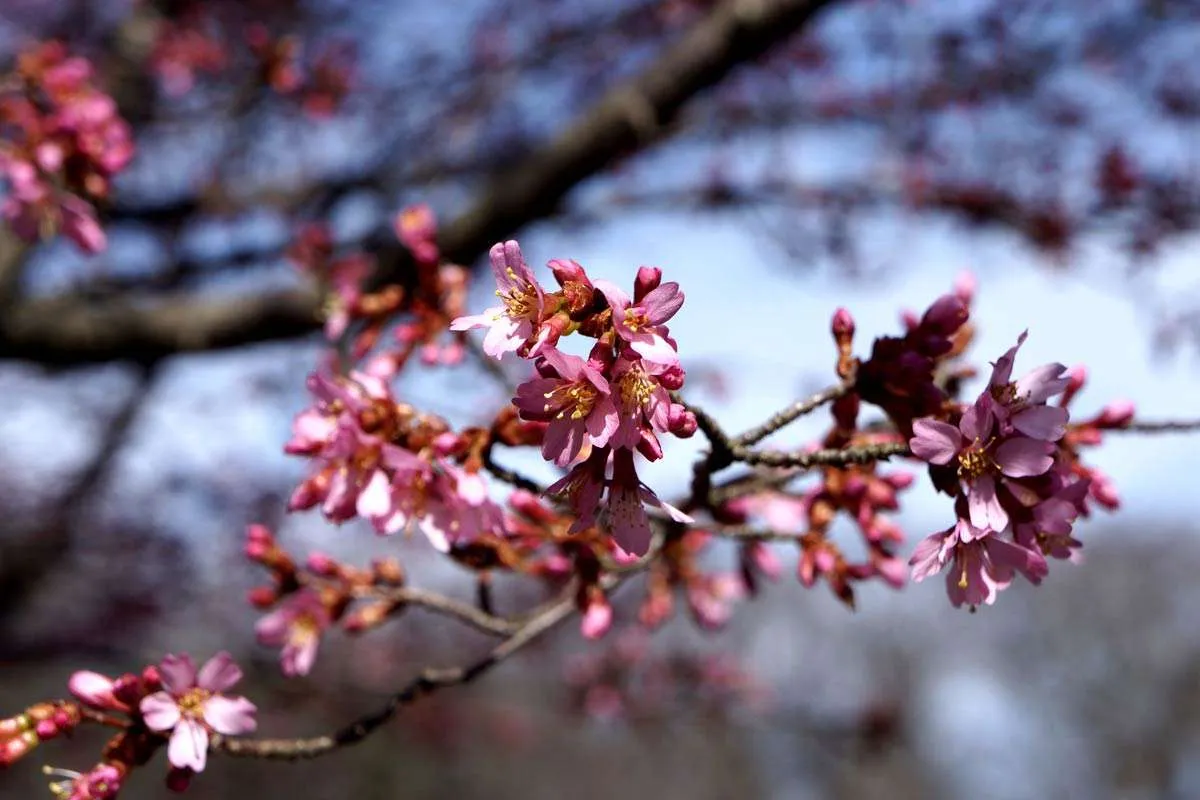
The Okame cherry tree earns its praise for being the earliest Cherry Blossoms to bloom in the spring. Being the earliest, this ornamental cherry tree takes the spotlight before any of the other cherry blossom trees.
Long before any of the other ornamental cherry blossom trees begin to prepare for it, the Okame blossoms are all set. These cherry tree blossoms are ready to bloom in the very early spring season.
The semi-double blossoms and bright pink color flower is an eye candy for spectators. The spectators for their part can’t seem to get enough of viewing these beautiful blossoms.
8. Weeping Cherry Tree
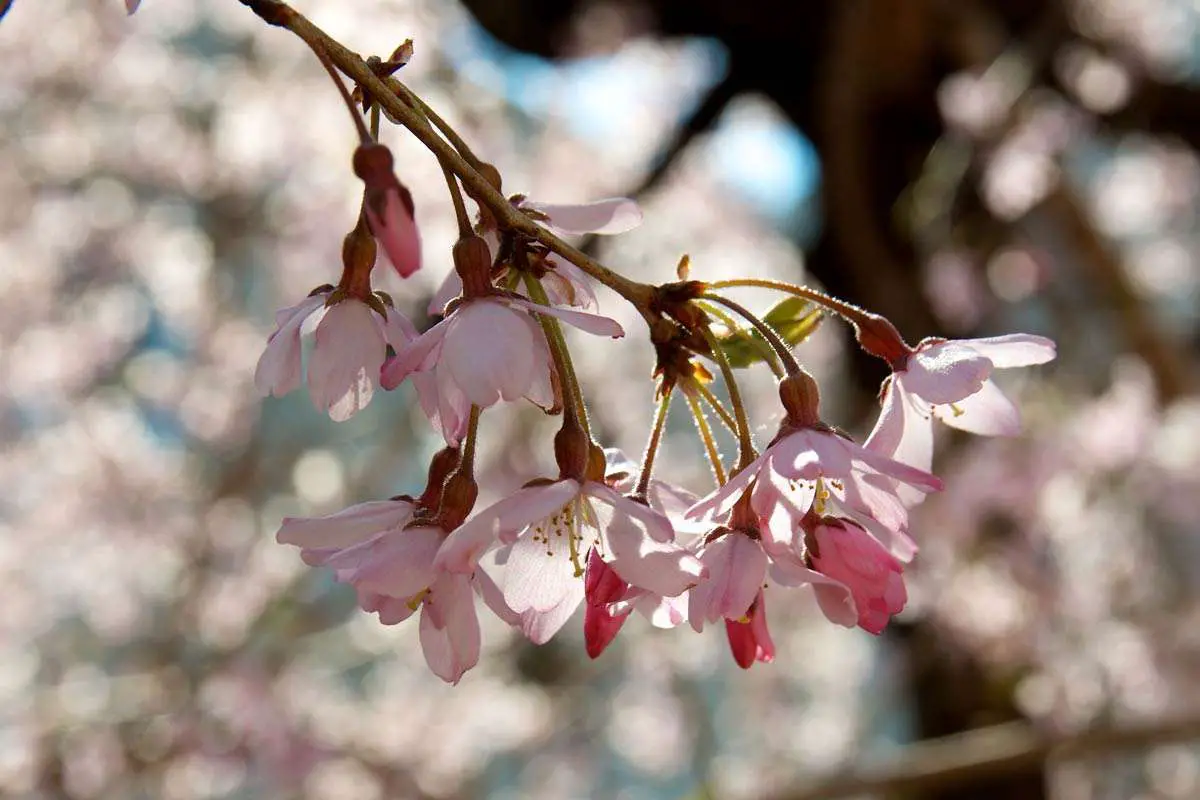
When it comes to uniqueness, the Weeping Cherry Tree is among the ones taking the proverbial piece of cake. As the name suggests, the flowers have a droopy look making it amongst the most unique cherry trees around.
This unique quality, along with its beautiful flowers, can catch the attraction of viewers amongst a bunch of cherry blossoms. The exact description of the Weeping Cherry tree may be harder to describe.
The reason behind it is the way it was originally cultivated in Japan many centuries ago. The Weeping Cherry tree was originally cultivated by grafting one cherry tree onto another.
The idea was to give it that unique ‘weeping’ effect. For this reason, this particular subspecies has a lot more variety than other subspecies. This also makes it harder to pin down what it might look like.
This unique trait of the Weeping Cherry Tree certainly makes it a favorite at a cherry blossom festival. It also gives it a top spot in the list of Ornamental Cherry Trees you might want to consider buying for your garden.
How to differentiate a Cherry tree from the Ornamental Cherry Tree?
The easiest way to differentiate it would be to do it in spring when the Trees are in full bloom, the type of flowers it has will tell you most of the things you need to know. Apart from that, you can compare the leaves, bark and other factors to differentiate between them.
While most of the Ornamental Cherry Trees don’t bear fruit, some of them do but they are not edible which is why they fall under the category of the Ornamental Cherry Tree.
Is your homeland environment suitable to grow a cherry tree?
Like every other tree, certain regions have the advantage over the others when it comes to growing cherry trees. The best place to look for that information would be to check out the “map of hardiness zones” provided by the USDA.
Some Important factors for Growing and Keeping your Cherry Tree Healthy
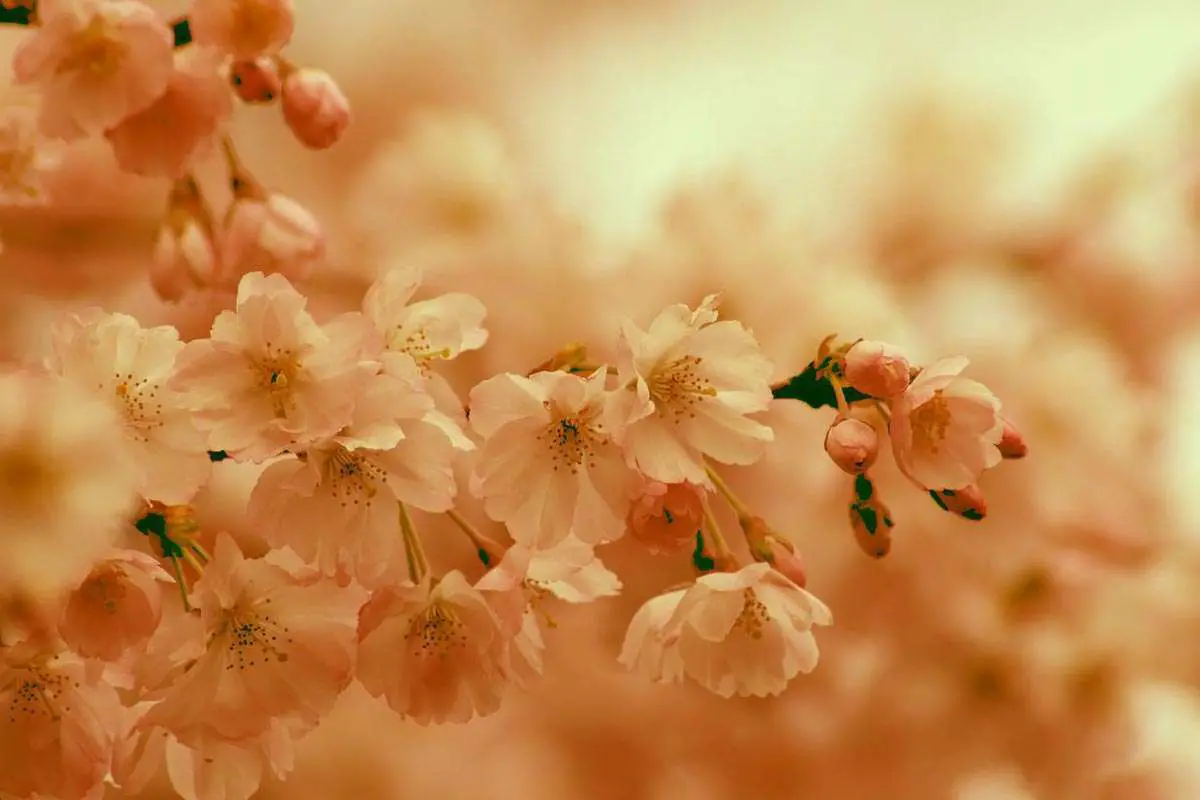
The lifespan of cherry trees depends on the species you are growing. Some of them have life spans of around 15 years while others can live up to 20-25 years.
During this lifetime, some factors will help you keep your cherry tree growing experience healthy and delightful.
1. The Right Spot
Picking up the right location can ensure a healthy cherry tree. It is important to pick a spot where it can get the maximum amount of sunlight, fertilized soil and water.
Crowding up your space with different kinds of plants is no good. None of them will get sufficient sunlight, water or nutrients. With this species of flowering tree, other plants growing close can affect the long-term health of your cherry tree also.
Some plants absorb more nutrients from the soil than others. That’s why it’s better to plant your cherry tree away from other flowering plants and trees.
2. Fertilize
Just like humans, plants are living organisms and they need their nutrients. After confirming your region from the USDA Hardiness zones, it is important to provide the right amount of mulch and nutrients.
This will ensure that your cherry tree grows healthy and tall with a beautiful, healthy leaf cover and flowers. Choosing the correct fertilizer for your cherry tree will also prove beneficial for the cherry blossom tree’s long term health.
3. Keep it Hydrated
You need to make sure your cherry blossom tree is getting enough water for it to remain healthy. Water your cherry tree often and provide it special care if you’re in a region with less rainfall.
Starting out…
Hopefully this’ll be a helpful starter guide if you’re looking for the perfect Japanese cherry blossom tree for your garden. At this point, do remember that chokecherry and black cherry trees are native to North America.
However, if it is Japanese cherry blossoms that you are looking for, then in Los Angeles, you could try to grow Yoshino trees. Do watch out for the chill though, since these trees are not the most hardy or most cold resistant.
And if you really want to enjoy looking at blossom trees, head over to San Francisco in early spring. Enjoy the Cherry Blossom Festival in Japan and make it a trip to remember
Cherry blossom is called “sakura” in Japanese, and the festival is usually celebrated in late March or April. It is timed to start with the flowering period of cherry trees.
